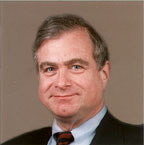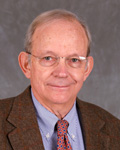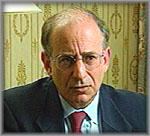Samuel "Sandy Burglar" Berger
Nexus 9/11 and NAU
Between 1992 and 1996, Sandy Berger was the Chairman of
the Deputies Committee of the National Security Council.
There are no red flags there - unless you happen to
have read an obscure little book titled,
"Summitry in the Americas: A Progress Report" by
Richard Feinberg, the "Architect of the Free Trade of the
Americas". The book, was written in 1997 and
in it, Feinberg details the history leading up to the first
Summit of the Americas in Miami in 1994. In the book,
Feinberg writes:
"The deputies were the focal point of policy making on the trade initiative and, as the summit approached, they devoted much more time to it than any other single initiative (figure 4.1: US Decision Making on Trade Policy). A number of NEC deputies--including Charlene Barshefsky from USTR, Joan Spero and her alternate, Daniel Tarullo, from State and Robert Kyle from the NEC staff-- were experts on trade policy. NEC co-chairs Bowman Cutter and Samuel Berger had considerable trade experience in both the public and private sectors" [pg 75].
"There was no NSC subcommittee, no standing cabinet-level group, no Deputies Committee (DC) dedicated to hemispheric affairs. However, this very lack of focus and coordination had made it possible for a few individuals to circumvent bureaucratic procedures and gain presidential approval of the summit. [pg 79]
Administration officials realized that a massive undertaking like the summit would require more formal interagency coordination.... Deputy National Security Adviser Samuel Berger convened the first DC on the summit on 7 February 1994 to discuss summit themes. Deputies present included Leon Fuerth (Office of the Vice President), Bowman Cutter (NEC), Joan Spero (State), Lawrence Summers (Treasury), Charlene Barshefsky (USTR), Carol Lancaster (USAID), and Frank Wisner (Defense). Commerce, US Mission to the United Nations, the Environmental Protection Agency (EPA), the Joint Chiefs of Staff (JCS), and the NSC were also represented... [pg 80]
The Presidential Decision Directive (PDD) on hemispheric affairs, which set the framework for administration policy and would be signed by the president was drafted at middle and working levels with senior-level clearances obtained by NSC staff by telephone. Not once had the principals or deputies met to consider the PDD. [pg 80]
...That foreign policy is economic policy is not a new finding. In preparing an important foreign policy initiative such as the Summit of the Americas, the greater novelty was involving many agencies whose primary jurisdiction is domestic. Agencies such as Interior, EPA, Transportation, Education, Labor and Justice have developed international sections with interests in Latin America and the Caribbean. [pg 82] [Note: The creation of international divisions in domestic government departments began during the Reagan Administration when he signed the La Paz Agreement establishing an international zone on the U.S. Mexican Border.]
So it's safe to say that Sandy Berger was
consumed with planning the sellout of America via
the Summits of the Americas. That's not a guess.
That comes from Feinberg: "The deputies were the
focal point of policymaking on the trade initiative, and as
the summit approached, they devoted much more time to it
than to any other single initiative".

Samuel "Sandy" Berger
Senior Foreign Policy Advisor to Clinton during 1992 campaign.
Assistant Transition Director for National Security for 1992 Clinton-Gore Transition
1992-1996 Deputy Director of the National Security Council
1996-2000 National Security Advisor to the President,
Bill Clinton
Richard Feinberg
Architect of the Free Trade of the Americas
Author of "Summitry of the Americas: A Progress Report", Institute for International Economics, Washington, DC, 1997

Anthony Lake
Senior Foreign Policy Advisor - Clinton-Gore campaign 1991-1992
Assistant to the President for Nation Security Affairs 1993-1997
Feinberg included two organization charts in his book that graphically show the degree of focus on planning for the summit. And it isn't at all surprising that Berger was involved in trade policy and the summit when you consider that before his stint with the Clinton Administration, Berger was a partner and the head of the international trade division of the law firm of Hogan & Hartson.
What is not believable is that he was involved with middle eastern 'terrorism' and Osama Bin Laden. Feinberg writes:
"At the initial meetings of the committee, the national security agencies were invited, including the Department of Defense (DOD), JCS, and Central Intelligence Agency (CIA). But traditional security issues, especially military issues, were not prominent on the summit agenda. Political, economic and social issues had largely replaced traditional security issues on the US hemispheric agenda; implicitly, the United States had redefined hemispheric security as democratic stability, economic progress, and social integration. Nor were CIA threat assessments relevant to summit preparation. As time went on, the seats formerly allocated to the defense and intelligence chiefs were occupied by representatives from such agencies as Commerce, EPA, and the agency most directly focused on the new security issues of international crime, the Department of Justice." [pg 82].
Berger did such a "heck of a job Bergie" on the Summit of the Americas in the Deputy position, that he was promoted to Assistant to the President for National Security Affairs after Anthony Lake left. It was in that capacity that Sandy Berger was called to testify before the 9/11 Commission regarding the Clinton Administration policies and actions pertaining to terrorism - and in particular, Osama Bin Laden.
9/11 Commission Testimony
With that in mind, it's time to re-read the
transcript of the 9/11 Commission hearing that was held on
March 24, 2004. The 24th was the day that George
Tenet, Sandy Berger, Richard Clarke and Richard Armitage
testified. Given that we now know what Sandy Berger
was really working on in the Clinton Administration, it
makes a whole lot more sense that the Deputy Executive
Director for the 9/11 Commission, Chris Kojm basically
testified for Sandy Berger in the form of a staff statement
before the Commission was allowed to question the witnesses.
And don't miss the disclaimer by Philip Zelikow:
From Chris Kojm's testimony in the hearing on the 24th regarding the CIA actions in Afghanistan in the late 1990's: "They called the new strategy simply, "The Plan."
George Tenet elaborated on "The Plan" when he testified:
"We recognized, through our collection analysis and disruption efforts of the '90s, that we had to change to meet this evolving threat. We had captured and rendered terrorists for years, but we knew we needed to go further to penetrate the sanctuary bin Laden found in Afghanistan. We knew that because our technical coverage was slipping, Al Qaida's operational security was high. We were taking terrorists off the street, but the threat level persisted....
So we did change. We developed a new baseline strategy in 1999. Simply we called it The Plan. We worked on The Plan through the summer. We told our customers and counterparts in Washington all about it." And we developed a network of agents inside Afghanistan who were directed to track bin Laden. We worked with friendly tribal partners for years to undertake operations against him.
Our human intelligence rose markedly from 1999 through 2001. By September 11th, a map of Afghanistan would show that these collection programs, human networks, were in place in numbers to nearly cover the country.
The array meant that when the military campaign to topple and destroy the Taliban began in October of 2001, we were able to support it with an enormous body of information and a large stable of assets. These networks gave us the platform from which to launch the rapid take-down of the Taliban.
THAT - is what's called setting the stage for redirection of attention to the Middle East after 9/11 and building an alibis all at the same time. Ray McGovern, former CIA analyst confirms that for us when, according to SourceWatch, he accuses Condoleezza Rice and the Bush Administration of malfeasance because they failed to heed Tenet's warnings:
"According to former CIA analyst, Raymond McGovern, CIA Director George John Tenet "warned the President of the United States about the threat of terrorism almost ad nauseam during the entire spring and summer of 2001. In the final analysis, the president had been warned often enough and long enough. He should have done something about it."
"Bush didn't know what to do," McGovern says. "And Condoleezza Rice, his advisor on such things, didn't know a thing about terrorism. By her own admission she hadn't opened the file that [Clinton's National Security Advisor] Sandy Berger left behind that said 'Read This File First.' She knew a lot about the Soviet Union and Eastern Europe, but nothing about terrorism. The charitable explanation for why nothing was done is gross ineptitude and gross malfeasance," he said."
And listen to Paul Thompson's testimony regarding the Advanced Warnings. Paul Thompson saying the code name for 9-11 was "The Big Wedding".
And speaking of setting the stage - before moving on to redder pastures, this is good time to mention that Richard C. Holbrook gave Sandy Berger kudos for the job he did as Deputy Director of the National Security Council during the first term of Clinton's Administration. That would indicate that Richard C. Holbrook was privy to the Summit planning and events. Why is that relevant? Because Richard C. Holbrook was one of three people who within hours of the collapse of the WTC towers, provided the media with the myth of 9-11 that became the official story line.
CNN Breaking News, Richard Holbrooke, Former U.S. Envoy speaking
"Bin Laden has said that the Taliban Leader, Mullah Mohamed Omar is the true spiritual leader of the Muslim world. He said that Afghanistan is the purified Islamic state equivalent to Mecca and Medina and in a tape that the New York Times wrote about 2 days ago, he urged Muslims everywhere - and Iím quoting the New York Times - to migrate to Afghanistan to support the Taliban, saying it is....MORE (brainwashing phase 3)
"The Plan"
There are just a couple of passages from the report that I'll include here even though the entire report is worth reading:
From the transmittal letter to the President:
The New Global Agenda - "The end of the Cold War and recent changes in the global economy have expanded the international agenda. Globalization will have a growing impact on definitions of U.S. "foreign policy", on the instruments available, the relative degree of control over events exercised by governments as opposed to the private sector and nongovernmental organizations (NGOs) and interconnections between events in different parts of the world"
Fostering Global Economic Order - "we recommend that you take proactive measures to extend and deepen economic ties with Latin America, especially with Mexico, for the purposes of fostering a stable, democratic and free-market-oriented hemisphere. The key components of this policy would include efforts to promote balanced and sustainable economic development, to ensure monetary stability, to extend and deepen free trade areas throughout Latin America, and to promote a hemispheric security community.
Asymmetric Warfare - During your administration, key challenges to the security of the United States, its allies, and its friends can come from so-called asymmetrical warfare, conducted by a variety of countries and non-state actors, in part as a response to U.S. military dominance. Three areas are most important: terrorism, cyber threats to critical infrastructure, and WMD and the means of delivering them.
Introduction - regarding who is in charge
Governments are less in control of foreign policy than they were only a few years ago; global politics is increasingly being shaped by nongovernmental organizations (NGOs) and by private-sector and financial entities that transcend tradition state borders. For most countries, sovereignty is eroding--in some places, such as the European Union (EU), by design; elsewhere, as an unintended consequence of the digital age. Resentment of globalization is on the rise and has produced increased anti-Americanism, since Washington is perceived as its architect.
First Steps - appointments
"Unless you decide to retain some top officials from the current administration, the only two senior members of the foreign policy team who can start work immediately on Inauguration Day are the members of the White House staff, namely the National Security Advisor and the director of the NEC. The others require Senate confirmation".
First Steps - people and process
At the outset--and until you can determine whether you are being well served--you can achieve this goal by adding officials to the structure of the NSC, including people from "nontraditional" areas...
We recommend that you create a new body, within the NSC, charged with the strategic analysis, long-range planning, and assessment of tradeoffs among the multiple issues that make up "national security" in the post-Cold War world.... This new body-- a Strategic Planning Office--can provide you and the members of the NSC with a broad, long-term perspective, it should also draw upon the work of the National Intelligence Council (NIC), as well as policy planning staffs in the cabinet departments engaged abroad, thus improve interagency coordination on long-term issues.
Finally, because of changes in global security and the nature of American involvement and presence, U.S. foreign policy will now be importantly affected by decisions made and carried out by non-governmental organizations (NGOs) and the private sector, often without a direct role by the U.S. government.
Possible Crises and Opportunities - At the beginning of the Clinton Administration, Saddam Hussein sought to challenge the new president by provoking a crisis in the Persian Gulf. He may do the same to you; and even without a crisis, you will face a difficult situation in Iraq....How you respond to such challenges will shape not only Saddam's future actions, but also those of others in the Middle east. It will also have an impact on long-term U.S. goals, including peace between Israel and the Arabs, limiting the proliferation of WMD, and the security of the oil-rich states.
We recommend that.... If provoked, U.S. air attacks on Iraq should hit a wider range of strategic and military targets. Current U.S. strikes on air defense systems accomplish relatively little. As long as you are willing to pay the political and operational costs of a continued military campaign against Iraq, the campaign should be directed against targets that count: the forces of elite units, regime protection assets, and suspected WMD sites.
The United States and other Western states should, in any event prepare for the possiblity of temporary reductions in Iraqi oil exports. You should consider an agreement with our allies that in the event of an Iraqi-inspired oil crisis, we will all draw on strategic reserves until other producers can replace as much of the shortfall as possible.
